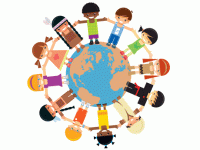A Global View: The Adventure of Kid-Friendly Foreign Films
Your content has been saved!
Go to My Saved Content.For many of us, Oscar week can serve as the annual reminder of how many great grown-up films we have yet to see, and how many kids' movies we've already seen -- over and over and over. Next time you're faced with indoor recess or a snow day, movie night or a free period before a holiday, resist the temptation to pop in Finding Nemo or Shrek (though I love these, too), and use the opportunity to take a journey around the world. Of all the great global learning tools out there, films from diverse countries are among of my very favorites.
The Benefits of Active Viewing
First and foremost, a good movie draws us in, and we simply enjoy the experience. Beyond that, watching a film can go from a passive experience to an active, engaged, curious exploration of big life themes and various academic disciplines.
A ten-minute clip (or shorter) from a film like The Story of the Weeping Camel from Mongolia might suffice to create a powerful discussion prompt on geography and language, on different perspectives about material luxuries, survival, family, how loved ones are cared for, being kind and considerate, what different living environments look like and how they are built, and how kids play or entertain themselves in different settings. It also can help foster empathy and bring alive an otherwise unknown culture. The diverse forms of expression embedded in films from faraway lands likewise can broaden creativity and possibilities for communication -- just to name a few of the many 21st century learning skills you might tap into.
Pre-screen movie trailers or short clips, easily accessible through YouTube or Vimeo, and archive your favorites to fill a gap on a rainy day or to weave into literature, social studies, music, art or science lessons.
Don't shy away from subtitles, either. Depending on your students' reading level, this can serve as a powerful literacy tool, and with practice won't feel like such a stretch. For pre-readers, having an adult read the subtitles aloud can also work. Education-conscious nations like Finland almost exclusively air subtitled films and TV shows, in order to cultivate a more literate national population -- and the strategy seems to be working.
6 Foreign Films for Every Classroom
While writing Growing Up Global, I took a particular interest in the benefits of foreign films for instilling global citizenship, and also realized how difficult it was to choose quality movies, since many of these are not rated, don't include age-appropriate guidelines, and rarely get the media attention of big Hollywood pics. Here are six of my favorite go-to films that any classroom can enjoy:
Ponyo (all ages)
A Japanese take on Hans Christian Andersen's The Little Mermaid that's filled with wonder and without the romantic obsession of Disney's Ariel displays, this is an all-ages, girl- and boy-friendly crowd-pleaser.
My Neighbor Totoro (all ages)
American audiences unfamiliar with the fantasy creatures in Japanese animation may take some acclimating to Totoro, but we find that our children are instantly transported into this film by Hayao Miyazaki, which has become an all-ages classic. Kiki's Delivery Service is another age-five-and-up favorite from the same Japanese animation team. We've met so many kids who were inspired to study Japanese language as a result of their love for these movies and later by the whole anime genre.
Like Stars on Earth ("Taare Zameen Par") (all ages)
An eight-year old boy in India, who faces discipline and learning challenges, is sent off to boarding school by his exasperated parents. An art teacher unlocks the boy's potential.
The Red Balloon (all ages)
This film is almost completely silent, following a simple balloon through a day in Paris. Yet the simplicity masks the diversity of experiences which every viewer of any age can take away from the story. It was acclaimed enough to win the 1956 Academy Award for Best Original Screenplay, as well as the 1968 Educational Film Award for Best Film of the Decade.
The Cave of the Yellow Dog
The Story of the Weeping Camel (both for age seven and up)
These films show life in Mongolia that is innocent, real and contemporary, yet worlds away from what we know. Central characters are real families, not professional actors. Some aspects of nomadic life may be hard for children to watch (e.g., vultures feed on an animal carcass, children are separated from their parents), but these are not in the context of any gratuitous violence or sinister character. Think of them more like a nature documentary. These would be good movies to watch actively -- after a scene, pause and process together, then re-start the movie and repeat.
Among this year's Academy Award nominees for best Animated Feature is Ernest & Celestine, a heartwarming French cartoon that's available with English narration by actors Forest Whitaker and Lauren Bacall, among others. Ernest & Celestine will be featured at The New York International Children's Film Festival, which also curates and distributes some of the best kids' films from around the world, including collections of fabulous, age-appropriate animated shorts.
What are some of your favorite foreign films to bring into the classroom?
